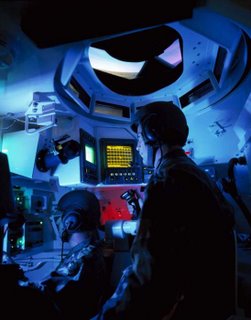


|

|
|
|
Home |
The Mil & Aero Blog
 Posted by John Keller For a long time now, U.S. military technology developers have been lying awake at night thinking about how to counter the low-tech threat: improvised explosive devices (IEDs), cell phone-carrying informants, garage door-opener triggers, and unguided rockets. It's been a long time since we talked seriously about the kinds of advanced-technology military threats that we did 10 or 20 years ago. Yet lately I'm starting to feel like it's deja vu all over again. Look at the news reports from Russia. New ICBMs, advanced theater ballistic missiles, and modernized surface warships on exercises where they can be seen up close. It's beginning to feel a lot like the '80s. I remember those days well when I was a cub reporter in Washington covering the Pentagon and Capitol Hill, with Ronald Reagan in the White House talking about the 'Evil Empire' and singing the praises of Rambo. Those were the days when we all looked forward to that annual Pentagon press conference where senior officers released what I called the 'Scare Book' -- the slick, four-color booklet called Soviet Military Power. Ah, those were the days of the advanced-technology threat; no IEDs for us. That booklet is where we learned about the Soviet Typhoon-class ballistic missile submarines, SU-27 Flanker jet fighters, Kirov-class cruisers, T-80 main battle tanks, Akula-class attack submarines, and anything else in the Soviet inventory that would scare us half to death. Now I'm wondering if the Scare Book will be resurrected anytime soon. I just read the other day in Defense Update.com about the newest Russian main battle tank, the T-95, which is supposed to enter service in 2009. I got the same shiver I used to get reading Soviet Military Power when I saw the story: In 2009 the Russian Army is scheduled to receive a new main battle tank, claimed to be superior to existing designs. The new tank will introduce a new hull, power plant and drive train. It will also have improved firepower, comprising of new armament, target acquisition, fire control and surveillance systems. It sounds like the folks in the vetronics lab at the U.S. Army Tank-Automotive Command outside of Detroit have their work cut out for them. The same goes for the scientists at General Dynamics Land Systems in nearby Sterling Heights, Mich., as well as tank designers in Israel, France, Germany, and elsewhere. It looks like there's about to be a big, tough, new kid on the block, and anyone concerned with tanks and other armored vehicles had better start thinking about it. It's been quite a while since main battle tanks were the prime topic of discussion. I remember when the Army's M-1 Abrams tank was the toughest tank around. That was -- well, it must have been back in the '80s. I think the next generation of tanks will have to be unlike any other. First, the new tanks must rely on much more than just their armor. They'll have to be fitted with advanced vetronics like active air defenses capable of shooting back at fast-moving attack helicopters and strike fighters. They'll need sophisticated electronic warning systems, and advanced optical targeting systems that will help them get off the first shot. Many other changes will be in store, as well. We'll see if the next generation of main battle tanks will be manned, unmanned, or a combination of both. One thing is clear, however. It's time, once again, for the tank designers to get busy. << Home |
Welcome to the lighter side of Military & Aerospace Electronics. This is where our staff recount tales of the strange, the weird, and the otherwise offbeat. We could put news here, but we have the rest of our Website for that. Enjoy our scribblings, and feel free to add your own opinions. You might also get to know us in the process. Proceed at your own risk. 
John Keller is editor-in-chief of Military & Aerospace Electronics magazine, which provides extensive coverage and analysis of enabling electronic and optoelectronic technologies in military, space, and commercial aviation applications. A member of the Military & Aerospace Electronics staff since the magazine's founding in 1989, Mr. Keller took over as chief editor in 1995.  Courtney E. Howard is senior editor of Military & Aerospace Electronics magazine. She is responsible for writing news stories and feature articles for the print publication, as well as composing daily news for the magazine's Website and assembling the weekly electronic newsletter. Her features have appeared in such high-tech trade publications as Military & Aerospace Electronics, Computer Graphics World, Electronic Publishing, Small Times, and The Audio Amateur.
Courtney E. Howard is senior editor of Military & Aerospace Electronics magazine. She is responsible for writing news stories and feature articles for the print publication, as well as composing daily news for the magazine's Website and assembling the weekly electronic newsletter. Her features have appeared in such high-tech trade publications as Military & Aerospace Electronics, Computer Graphics World, Electronic Publishing, Small Times, and The Audio Amateur.
 John McHale is executive editor of Military & Aerospace Electronics magazine, where he has been covering the defense Industry for more than dozen years. During that time he also led PennWell's launches of magazines and shows on homeland security and a defense publication and website in Europe. Mr. McHale has served as chairman of the Military & Aerospace Electronics Forum and its Advisory Council since 2004. He lives in Boston with his golf clubs.
John McHale is executive editor of Military & Aerospace Electronics magazine, where he has been covering the defense Industry for more than dozen years. During that time he also led PennWell's launches of magazines and shows on homeland security and a defense publication and website in Europe. Mr. McHale has served as chairman of the Military & Aerospace Electronics Forum and its Advisory Council since 2004. He lives in Boston with his golf clubs.
Previous Posts
Archives
|
|||||
Online treasures
THE MAE WEBSITE AUTHORS ARE SOLELY RESPONSIBLE FOR THE CONTENT AND ACCURACY OF THEIR BLOGS, INCLUDING ANY OPINIONS THEY EXPRESS, AND PENNWELL IS NOT RESPONSIBLE FOR AND HEREBY DISCLAIMS ANY AND ALL LIABILITY FOR THE CONTENT, ITS ACCURACY, AND OPINIONS THAT MAY BE CONTAINED HEREIN. THE CONTENT ON THE MAE WEBSITE MAY BE DATED AND PENNWELL IS UNDER NO OBLIGATION TO PROVIDE UPDATES TO THE INFORMATION INCLUDED HEREIN.
|
||||||
|
|
Home | About Us | Contact Us | Corporate Website | Privacy Policy | Courage and Valor Foundation | Site Map
Also Visit: Laser Focus World | Vision Systems Design | Industrial Laser Solutions Copyright © 2007: PennWell Corporation, Tulsa, OK; All Rights Reserved. | Terms & Conditions | Webmaster |
Battle tanks are good for wars fought against massed forces, but that may be a bygone era. It's kinda like the redcoats marching a firing in formation against the colonial "terrorists" in 1776. Not a good idea to go into a field of battle while the enemy hinds behind rocks and trees.
Your point about personnel-less vehicles is well-taken, but what do we do when the battlefield is automated and all we are doing is blowing up automated vehicles with automated vehicles. Not much more effective than a video game, but much more expensive.
Wednesday, January 2, 2008 5:25:00 PM EST
Friday, January 2, 2009 9:21:00 AM EST